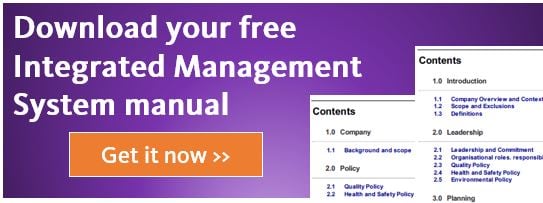Time to Go Back to Basics
Recently I hosted a webinar with special guest and fellow QNewZ contributor Michael Voss (Michael is also a Mango partner). It was all going swimmingly until the question was asked of our attendees "who has an integrated management system?”. The answer was – and I was more than a little taken aback by this - not many. In fact, the vast majority confessed to not integrating their systems. And when you hypothesise that people who attend quality webinars are likely to be the most motivated and forward-thinking of their peer group, I can only conclude that integrated management systems are exceedingly thin on the ground.
I think it’s time to go back to basics. What is an integrated management system and why do many quality professionals think it’s a jolly good idea?

Organisations are required to run at least one - but usually more – management systems. The first requirement is a health and safety system. So that’s system number one in our basket. Then businesses have Quality Management Systems that could be certified to something like ISO 9001. Now we have two systems on the go. On top of that, Environmental Management Systems can become involved or Food Safety Management Systems need to be set up. Obviously Financial Management Systems are also implemented. I think you get the idea here because this list goes on and on. So potentially we have four or more systems to keep on top of.
The point of an integrated management system is that you mesh all of these systems together. You don’t want silos, you want seamless.
For instance, instead of running 3 or more different databases of employee competencies, you run just one. Instead of carrying out 3 or more different internal audits, you carry out just one. Instead of having 3 or more procedures for document control, you have just one.
Already one of the advantages of having an integrated management system is obvious – it’s the elimination of duplication, and thus the saving of precious time and resources. That kind of efficiency is not to be sneezed at.
Efficiency isn’t the only gain, though. There are a myriad of other advantages, such as (hat tip to the Chartered Quality Institute in the UK):
- Improving communication. For example, staff will only need to read one procedure and not four to five that are saying the same thing for each system.
- Balancing conflicting objectives. For example, the quality system may have an objective that conflicts with the health and safety system. Combining these together could balance them out.
- Facilitating training and development. For example, the management of training records will be simplified if only one system is used.
- Create consistency. For example, having one system will mean a consistent approach to internal auditing.
- A common general structure (table of contents): identical chapters, article numbers, and chapter, article or clause titles, etc.
- Introductory texts for identical articles
- Identical wording for identical requirements
- Common terms and core definitions
Thus ISO is making it easier to integrate your systems so that the standards they need to meet will have consistent message. Even they are making it easy for you.
The overall aim of an integrated management system is to simplify and streamline things because complexity is a source of risk. The simpler we make things, the more control we have, and the less risk we are exposed to.
Takeaway
So here's why you should seriously consider integrating your processes:
- Integration means a reduction in duplication.
- Integration means a reduction in time and effort.
- Integration improves communication, balance objectives, facilitates training and development and creates consistency.
- Integration reduces risk.
.png?width=200&height=51&name=image%20(2).png)




